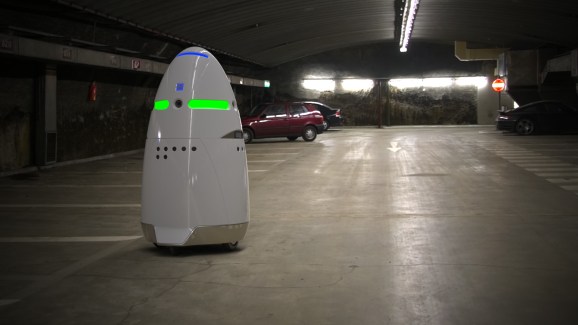
Knightscope founder and CEO William Santana Li is not modest in his ambitions.
He estimates that crime — of all kinds — has an annual global economic impact of a trillion dollars. That’s $1 trillion lost every year due to theft, vandalism, robbery, violence, and more.
He wants to cut that in half. And to do that, he’s building a fleet of surveillance robots.
The Knightscope K5 is a tall (about 5.5 feet), dome-headed, wheeled robot loaded with cameras and sensors. It rolls around at a slow speed, just a few miles per hour, and as it goes it emits a sort of drone-like humming sound. The sound is deliberate, so the robot doesn’t surprise people by rolling up silently behind them, but it also gives it a somewhat eerie presence — a sensation that’s probably appropriate, given that it’s watching your every move with a sensor suite that includes light detection and ranging (LIDAR) devices; high-definition, low-light video cameras; a camera designed to read and recognize the digits on license plates; directional microphones; proximity sensors; an inertial measurement unit; and a GPS unit.
The K5 looks a bit like a cross between R2-D2 and a Dalek, and that’s right where Knightscope wants it. The design challenge, Santana Li told me, is to make something that commands respect but isn’t frightening; that’s serious-looking but approachable. So, for instance, even though the technology might allow it, Knightscope is not going to make black-painted robots that zoom around at 20 miles per hour, because that would terrify people. Like police officers and security guards, the K5 aims to be a constant, calm, reassuring presence.
Knightscope seems to be succeeding in that. I find the robots eerie, but I’m also a born cynic. Most people apparently find them charming, and many people take selfies or family photos with the robots.
Now, Santana Li’s approach might strike some people as a little overly optimistic. Indeed, he had a difficult time convincing any Silicon Valley venture capitalists to back him. “Hardware is too hard,” is the refrain that many investors will tell you: It’s simply too expensive and too difficult to build a sustainable hardware business, particularly in a world where fast, professional, and cost-effective Chinese manufacturing is so dominant.
Santana Li has little patience with that. In a recent onstage interview I had with him at GSV Labs’ Pioneer Summit, he expressed exasperation at the crop of tech entrepreneurs who are tackling social media sharing and apps instead of challenging hardware innovations.
“It’s un-American for an entrepreneur to take the path of least resistance!” Santana Li yelled.
Undeterred by the lack of venture backing, Santana Li raised a total of $7 million from a State Farm-backed incubator, Flextronics, and NTT DoCoMo. The company said it has just four customers so far, but claims to have over 100 on its waiting list.
Santana Li is also impatient with the arguments that privacy advocates bring up. You don’t like having a robot rolling around your neighborhood, recording video 24-7? Well, think how you’d feel if you were a victim of crime, Santana Li said. Now what’s more inconvenient?
I don’t find that argument fully persuasive, but the analogy he draws with beat cops and security guards is a good one: Sometimes the mere presence of authority is enough to deter crime, and — given the recent push to put body cameras on police officers — it’s maybe not such a big step to having a fully autonomous camera-equipped robot rolling around.
Besides, for the most part, Knightscope is punting on the privacy and data storage issues: It will let its customers sort those questions out.
The pricing model is what’s perhaps most intriguing. Knightscope plans to rent its robots out for $6.50 an hour — far lower than the $20 per hour most security guards make. With that, you’d get 24-7 coverage, a web-based console, and a slew of features that can supplement, not replace, whatever security force you already have. Customers could include businesses (for monitoring a mall or a parking lot, for instance), neighborhoods, or maybe someday even police forces.
And if Santana Li’s ambitions pan out, it could turn into a very big business. According to the National Institutes of Health, the U.S. spends $179 billion a year on police protection, legal proceedings, and corrections. At $6.50 per hour, supplemental security monitoring might look like a very economical alternative to policing and security guards — and with billions already being spent, Knightscope has the potential to carve off quite a big slice of revenue.
Just as long as it can keep from freaking people out too much.
